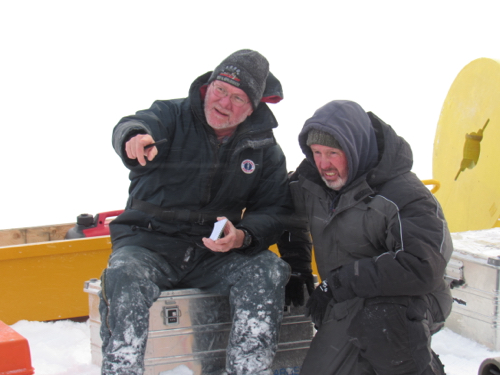News Update
Late last night we arrived at our now most northern point and first ice station which meant we would be on ice for a good chunk of the day. Our first ice station was coincidently our first polar bear sighting: a mother and two cubs.
 A polar bear sow and her two cubs off of the Louis S. St. Laurent.
A polar bear sow and her two cubs off of the Louis S. St. Laurent.
Because the ice was in the 1-2 meter thick range, it was decided to do all the "ice ops" right off of starboard side using the gangway for deploying the people and ships crane for moving the heavy equipment on to the ice. Luckily the bears were spotted about 300 meters off the port side but an armed lookout was sent out on the ice first. Two teams spent about four hours on the ice, the ice survey team and the ITP deployment team.
During the later part of yesterday, a helicopter reconnaissance flight determined that there was not suitable ice for ITP deployment so we steamed on through the night. We were treated to an extraordinary sunset late in the evening – one that you will only ever see in the high Arctic.
 Sunset in the high Arctic taken from the CCGS Louis S. St. Laurent at 80˚55 N.
Sunset in the high Arctic taken from the CCGS Louis S. St. Laurent at 80˚55 N.
Chemistry Timeout
Alright, back to some solution chemistry (chemisery??). So the amount of hydronium ions present in a solution dictates how acidic or basic a solution is. Now this is where the infamous pH scale comes in. I am certain that chemists came up with the pH scale in order to confuse everyone as much as possible. Actually the intent was to simplify the whole acid base thing but one could argue it made it much harder to learn.
So dig it: we count molecules in a quantity called a "mole" (don't ask). For solutions we talk about moles of a particular molecule per 1 liter of a solution, so moles/liters or abbreviated mol/L. We can have 1 mole of H3O+ in 1 liter of solution which is considered to be very acidic. You would expect the pH number to be large to reflect the fact that it is very acidic BUT Noooooo..... 1 mole of H3O+ in 1 liter of solution actually has a pH number of 0. Here is how it works: 1 mole of H3O+ in 1 liter of solution can also be written as 10^0 mol H3O+/L. A .1 mole of H3O+ in 1 liter of solution can be written as 10^-1 mol H3O+/L and has a pH of 1. A .001 mole of H3O+ in 1 liter of solution can be written as 10^-2 mol H+/L and has a pH of 2. So do you see whats shakin' here? The number in the exponent is the pH number with the negative sign removed. And that is why then the more acidic a solution, the lower the pH nimber and the higher the concentration (mol/L) of the H3O+ ions. What this implies we will get to next time.
Scenes from Activities Around the Ship
 Deployment of an ITP on the ice in the high Arctic.
Deployment of an ITP on the ice in the high Arctic.
 Rick Krishfield (WHOI) discusses ITP deployment with Jim Ryder (WHOI).
Rick Krishfield (WHOI) discusses ITP deployment with Jim Ryder (WHOI).
 The business end of the Icebreaker CCGS Louis S. St. Laurent. Taken at the first ice station for the JOIS 2017 cruise.
The business end of the Icebreaker CCGS Louis S. St. Laurent. Taken at the first ice station for the JOIS 2017 cruise.
 PolarTREC teacher Dave Jones on deck in the high Arctic on the Louis S. St. Laurent.
PolarTREC teacher Dave Jones on deck in the high Arctic on the Louis S. St. Laurent.

Comments
Add new comment